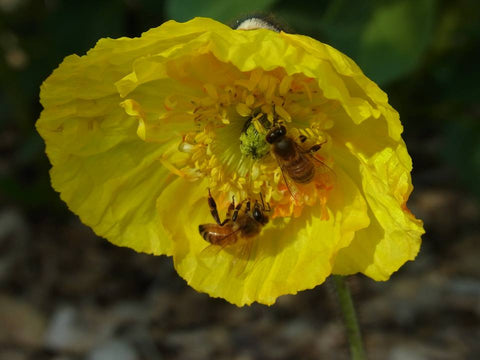At TerraTrellis we have a serious case of garden fever. It’s April, after all. Things are blooming, the weather is warming, and every time we check our inbox we’re reading about spring gardening tasks and swooning over garden landscapes, spring plants, and the upcoming edible bounty.
But, let’s face it. Gardening is hard work, and it takes more than a few weekend’s worth of tilling and digging to get the garden up and running every growing season. A garden’s success relies on an army of support staff, including the insect kind.
 photo by Christine Casey, UC Davis
photo by Christine Casey, UC Davis
This post is about the unsung heroes of the garden. Yes, often honey bees get all the glory: socializing, colonizing, and literally dying for their queen. But native bees, some of them solitary, have an equally important role in the garden. Native bees, including the bumble bee the carpenter bee and the mason bee, pollinate the flowers we fawn over and the fruits and vegetables we bring to the table.
 photo by Daniel Schwen
photo by Daniel Schwen
But new research suggests that bumble bees, one of more than 4,000 native bee species in the United States that supports our agricultural economy, are threatened, according to a report by the Nature Conservancy. And as the natural phenomenon known as Colony Collapse Disorder continues to threaten and shrink the honey bee population with a deadly combination of virus, pest, and bad agricultural management within a monoculture environment, it’s more important than ever that we pay attention to pollinators like native bees.
Commercial farmers are implementing new techniques, or revisiting traditional farming practices, to offset the effects of Colony Collapse Disorder, as reported in a recent New York Times article. Home gardeners can also do simple things to support these important pollinators. The least we can do is create a hospitable environment for them and entice them to stick around in our yard.
Before native bees can get busy in the garden, they need a place to nest. We created our Bee Bungalow to support the native bee habitat with hand cut reeds and hollowed branches where they build their solitary nests. A native bee’s lifecycle is short, but our Bee Bungalow is in the garden year round, providing a safe place for generations of native mason bees to rest and nest and do their thing.
 photo of TerraTrellis Bee Bungalow by Rob Wilson/Silas Tom
photo of TerraTrellis Bee Bungalow by Rob Wilson/Silas Tom
Even our other trellises like the Mira Garden Trellis and Akoris Garden Tuteur “support” native bees with their functionality. Flowering vines and climbing veggies, when grown on a garden trellis, elevate the colorful blossoms that they are drawn to.
Besides our Bee Bungalow, there are several other ways in which we can attract and retain native pollinators like native bees in our backyard.
Create a diverse plant palette
Diversity in the garden means that no one plant will throw off the garden’s ecological balance. Providing a smorgasbord of plant pollen and nectar with a variety of flower landing pads and pollinator receptacles welcomes a variety of pollinators. Consider plants like California poppy, wild mint, bush anemone, and zinnias. Mix it up with varieties, colors and textures of all kinds.
Avoid Pesticides in the garden
Every time a pollinator lands and feeds or drinks from a flower that has been treated with some form of chemical, that chemical is carried back to its nest and spread to other pollinators.
Plant perennial shrubs en masse
Many pollinators are more productive when they have a wide swath of flowers from which to forage. They’re also more likely to revisit your garden if they have a large area to cover. A flowering shrub, like rosemary or sage, is ideal.
Year-round bloom
Depending on the climate, some native bees begin emerging as early as January. Early blooming plants like manzanita provide pollen and nectar once they emerge. Even late fall blooming annuals can support native bees until they die off. The important thing is to provide plants that can support the different types of native bees for as long as possible.
 photo by Christine Casey, UC Davis
photo by Christine Casey, UC Davis
Want to learn more?
The Xerces Society has a Pollinator Conservation Resource Center that includes a state-by-state resource list including bee-friendly plants. It’s a collaboration with the University of California, Davis, which is one of the country’s leading academic institutions on native pollinators. The university’s Harry H. Laidlaw Jr. Honey Bee Research Facility, has an open-to-the-public Haagen-Dazs Honey Bee Haven, provides a wealth of information on native bee habitats and honey bee habitats.



